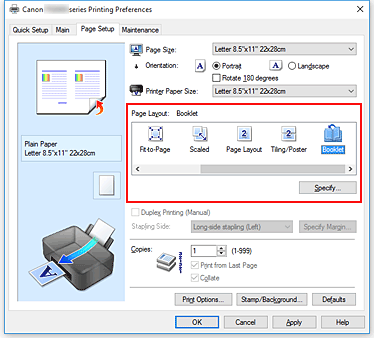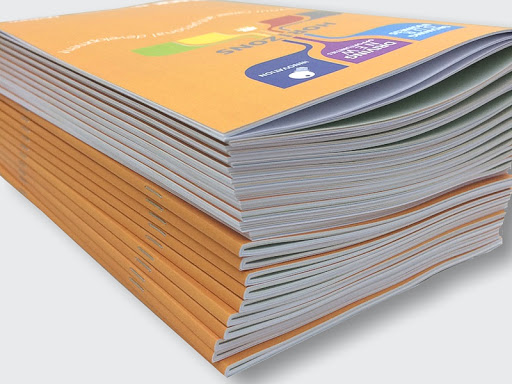Are You Using the Right Paper Stock for Your Booklet Printing Project?
Are You Using the Right Paper Stock for Your Booklet Printing Project?
Blog Article
The Essential Overview to Understanding Brochure Printing Options and Techniques
The procedure of booklet printing includes numerous factors to consider that can considerably influence the end product. From choosing the suitable format and dimension to comprehending the subtleties of binding techniques, each selection plays a vital role. In addition, factors such as paper stock and printing methods additional affect the effectiveness of the pamphlet. As one navigates these options, it ends up being imperative to comprehend exactly how they interconnect and what that suggests for the overall result.
Recognizing Booklet Formats and Dimensions
When taking into consideration brochure printing, understanding the various formats and dimensions readily available is necessary for accomplishing the desired discussion. Pamphlets can be produced in countless formats, consisting of saddle-stitched, spiral-bound, and perfect-bound, each offering distinct benefits. Common sizes vary from standard letter (8.5 x 11 inches) to smaller options like A5 (5.8 x 8.3 inches), allowing for versatility based upon material and target audience.Selecting the ideal dimension can affect both the design and viewers interaction. Bigger dimensions might match aesthetically driven material, while smaller sized formats may be more mobile and straightforward. In addition, the variety of web pages influences the option of binding approach, as thicker brochures might need sturdier bindings. Inevitably, recognizing these elements enables an extra tailored technique, ensuring that the end product straightens with the designated message and visual, boosting the overall effectiveness of the interaction.
Picking the Right Paper Stock

Binding Techniques: Factors To Consider and options
When it comes to binding methods for booklets, a number of options are available, each with unique advantages. Saddle stitch binding supplies an economical remedy for thinner pamphlets, while excellent binding strategies give a more polished try to find thicker magazines. Wire-O binding attracts attention for its toughness and ease of use, making it optimal for papers that need versatility.
Saddle Stitch Binding
Saddle stitch binding supplies a affordable and useful remedy for setting up brochures, making it a prominent choice among companies and authors. This binding method includes folding sheets of paper in half and stapling them along the fold line, producing a cool and well organized look. Generally suitable for pamphlets with a lower page count, saddle stitching is ideal for magazines, sales brochures, and educational products. The simpleness of this technique enables quick manufacturing and is commonly favored for short runs or promotional things. However, it is necessary to note that saddle stitch binding may not be ideal for thicker brochures, as the back might not stand up under increased weight. In general, it remains a dependable alternative for several printing jobs.
Perfect Binding Techniques
Perfect binding is an extensively made use of method that gives a polished and expert coating to publications and brochures. This method includes gluing the web pages together at the spinal column making use of a strong adhesive, enabling a tidy side and the capacity to hold a bigger variety of web pages contrasted to saddle sewing. Perfect binding is especially suitable for thicker brochures, such as catalogs and annual reports, where a tough, level back is preferred. Additionally, it offers the choice for a published cover that can be developed to enhance visual appeal. Factors to consider such as web page count, paper weight, and the intended use of the booklet ought to be taken into account, as they can impact toughness and total top quality.
Wire-O Binding Options
Wire-O binding, known for its sturdiness and adaptability, offers an outstanding option for booklets that need easy page turning and a specialist appearance. This binding method uses a collection of metal loops that hold pages firmly, allowing them to exist flat when open. It is especially appropriate for presentations, brochures, and manuals because of its robust nature. Wire-O binding is available in various shades and diameters, suiting various web page counts and densities. Furthermore, it permits the incorporation of tabs and covers, improving the pamphlet's overall visual. Factors to consider for Wire-O binding include the option of cable shade, the size of the loopholes, and the extent of personalization desired, all of which can profoundly influence the end product's appearance and capability.
Digital vs. Offset Printing: Which Is Best for You?
When selecting a printing technique for booklets, understanding the differences in between electronic and balance out printing is vital. Digital directory printing makes use of modern innovation to produce high-grade prints quickly and affordably, making it ideal for short runs or projects calling for quick turn-around times. It permits customization, offering the capacity to publish on-demand with marginal waste.In comparison, offset printing is a typical technique that stands out in producing large quantities with consistent top quality. It involves moving ink from a plate to a rubber covering, then to the paper, which results in lively colors and specific details. Nevertheless, balance out printing typically requires longer setup times and is extra economical for larger volumes.Ultimately, the choice in between digital and balance out printing depends on task requirements, budget, and desired amount. For little, time-sensitive projects, digital could be the finest choice, while countered may be more suitable for bigger, top quality productions.

Creating Your Brochure: Tips and Ideal Practices
When making a pamphlet, mindful attention to format, typeface option, and color use can considerably improve its efficiency. A well-structured design overviews the viewers's eye, while suitable font styles assure readability and communicate the desired tone. Additionally, efficient use color can evoke feelings and highlight essential info, making the general design more impactful.
Selecting the Right Layout
Just how can one effectively select the ideal layout for a booklet? It is important to review the booklet's objective and target audience. A tidy, organized format boosts readability and interaction. Making use of a grid system can aid in straightening components consistently, creating an expert appearance. Furthermore, incorporating aesthetic power structure with differing dimensions and placements of images and message can guide the reader's eye and stress key information. It is likewise crucial to leave sufficient white space, which avoids overcrowding and permits better focus. Examining various designs via mock-ups can supply understanding right into exactly how the design performs in real-world scenarios, guaranteeing that the final product fulfills both aesthetic and practical demands. Practical Picking Suitable Font Styles
A well-chosen font style can considerably improve the general design of a booklet, complementing the layout and strengthening the content's message. The choice of typefaces must take into consideration readability, particularly for body text, as it ensures the info comes to all readers. Sans-serif font styles are commonly favored for electronic styles, while serif font styles can offer a standard feel in published products. It's suggested to restrict font selections to 2 or 3 to maintain visual coherence. In addition, font dimension plays an essential role; headings should be distinctive however not frustrating, while body message must be comfortable for analysis. When selecting font styles, alignment with the brochure's motif and target audience is crucial for effective communication and visual appeal.
Efficient Use of Color
Color works as a powerful tool in brochure design, guiding and forming understandings visitor feelings. It can evoke feelings of trust fund, excitement, or peace, depending on the hues picked. Designers should think about color concept concepts, guaranteeing that the picked scheme lines up with the brochure's message and target market. For example, utilizing warm colors like red and orange can create urgency, while cooler tones like environment-friendly and blue foster tranquility.Additionally, contrast plays a vital function; complementary colors can enhance readability and aesthetic charm. Uniformity in color use throughout web pages further reinforces brand name identity and cohesion. Eventually, efficient color implementation not just my site captures interest however also enhances the brochure's purpose, making it a necessary facet of successful style.
Ending Up Touches: Coatings and Special Impacts
While numerous take into consideration the material and layout of a pamphlet one of the most critical components, the completing touches, such as finishes and special go now results, play a crucial role in boosting its total appeal. Coatings can offer security and resilience, making certain that the brochure holds up against wear and tear. Matte coatings supply an advanced, non-reflective surface area, while glossy finishings can make colors appear even more vibrant and attractive. Special effects, like embossing or foil marking, add a responsive measurement that can produce an unforgettable impact. These techniques can highlight specific areas, accentuating vital info or producing aesthetic passion. Furthermore, UV finishing can give a high-shine surface that raises the general look.Together, these completing touches not just improve the brochure's aesthetic however additionally interact expertise and attention to detail, ultimately leaving a long-term influence on the viewers.
Price Factors To Consider for Booklet Printing
Comprehending the various cost considerations for pamphlet printing is essential for companies and services intending to enhance their budgets. Trick aspects affecting expenses consist of the choice of binding, paper, and ink approaches. Better products, such as premium paper or specialized inks, normally increase the total cost. Furthermore, the dimension and page count of the pamphlet play a significant role; bigger pamphlets call for more resources and time to produce.Another vital consideration is the printing technique, whether electronic or balanced out, as each has its own prices framework and viability for various quantities. Organizations should likewise consider style prices, which can differ based upon intricacy and making use of expert solutions. Ultimately, shipping and handling costs can include in the total, specifically for large orders. By examining these aspects, companies can make informed choices that line up with their economic capabilities while accomplishing the desired quality in their published materials.
Frequently Asked Questions
What Are the Ecological Impacts of Booklet Printing?
The ecological influences of pamphlet printing include deforestation from paper production, carbon exhausts from transportation, and waste generation from discarded materials - Booklet Printing. Sustainable methods, such as making use of recycled paper and eco-friendly inks, can alleviate these results
Exactly How Can I Guarantee Shade Accuracy in My Pamphlet?
To guarantee color precision in a pamphlet, one should make use of calibrated screens, use specialist color accounts, conduct test prints, and select high-grade printing solutions that supply shade matching and proofing alternatives for ideal outcomes.
What Is the Typical Turn-around Time for Pamphlet Printing?
The typical turn-around time for pamphlet printing differs depending on the complexity and amount - Booklet Printing. Typically, it ranges from a couple of days to two weeks, influenced by variables such as publishing methods and completing requirements
Exist Minimum Order Quantities for Brochure Printing?

Can I Publish Pamphlets in Numerous Languages?
Printing pamphlets in several languages is possible. Several printing services offer choices for multilingual or multilingual layouts, permitting reliable communication. Cautious preparation guarantees that make aspects suit numerous languages without endangering readability or looks. Additionally, aspects such as paper supply and printing techniques further influence the efficiency of the booklet. When thinking about brochure printing, recognizing the different formats and dimensions readily available is important for achieving the preferred discussion. When picking a printing technique for brochures, recognizing the distinctions in between electronic and offset printing is essential. Additionally, the dimension and web page matter of the brochure play a considerable duty; larger booklets require more resources and time to produce.Another essential consideration is the printing strategy, whether digital or offset, as each has its own rates framework and viability for various quantities. The environmental influences of booklet printing include logging from paper manufacturing, carbon exhausts from transportation, and waste generation from disposed of products.
Report this page